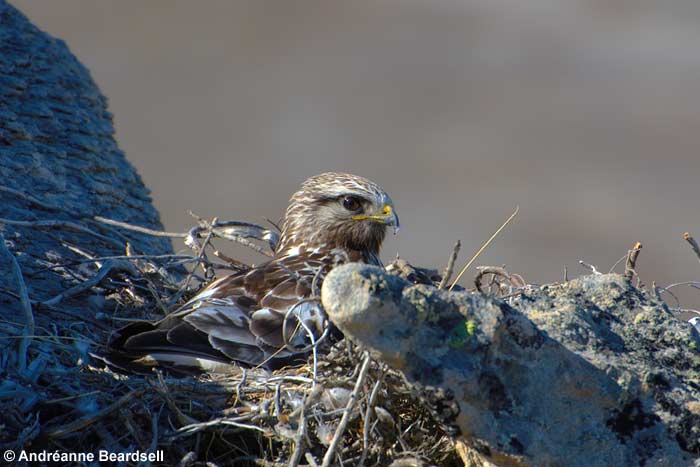
The rough-legged hawk is a medium-sized migratory raptor (average body mass: 950 g for males and 1,200 g for females) with a circumpolar distribution. In North America, it breeds in the Arctic (including Bylot Island) and winters in southern Canada and northern United States. Although the rough-legged hawk is known for consuming almost exclusively lemmings during the breeding season, it can also occasionally feed on alternative prey such as songbirds, ptarmigans, ducks and hares. On Bylot Island, when lemming populations are very low, very few or no hawks breed. This suggests that these alternative preys alone are not abundant enough to support breeding on the island.
Breeding ecology
Since 2007, we have been monitoring the reproduction of the rough-legged hawk on the southern plain of Bylot Island over an area of approximately 500 km2 where more than 100 nesting structures have been recorded so far. These nests are revisited every year and systematic searches are also carried out in all the potential nesting habitats of hawks, such as along cliffs, ravines or large rocky outcrops, in order to locate all active nests. When an observer or a predator approaches their territory, alarm calls from nesting individuals help locate active nests. Up to 42 nests are found active annually in our study area and they are monitored regularly from egg laying, through hatching and fledging of young in mid-August.
At some sites, hawks build their nests directly on the ground but on Bylot Island all nests are located on cliff edges, steep hillsides and hoodoos, reducing access to terrestrial predators such as the arctic fox. To build its nest, the hawk uses branches and roots to form a structure between 60 and 90 cm in diameter. Like most raptors, the hawk tends to reuse old structures to nest year after year. This strategy significantly reduces the energy costs of building the nest, and it saves time on arrival at the breeding grounds to start laying as quickly as possible. In addition, the low abundance of shrubs on Bylot Island makes the material needed to build nests scarcer. Just over 40% of the territories (area used by only one breeding pair at a time) contain more than one nesting structure (1 to 4), but only one is used at a time. However, these other structures can be useful if one collapses as the breeding season approaches. Given the territorial behavior of the rough-legged hawk, the distance between two active nests is on average 3.3 km.
The female begins laying eggs quickly after arriving on Bylot Island, between the end of May and mid-June (average: June 7). The female lays 3 to 5 eggs, sometimes even up to 6. Then, 31 to 33 days after the first egg is laid, the first one hatches (between June 28 and July 21). Since incubation begins as soon as the first egg is laid, hatching is also delayed by 2 to 3 days between each egg. On Bylot Island, hatching success (proportion of nests with at least one hatched egg) is relatively high (around 80%). However, a recent study on Bylot Island showed that several factors such as the availability of food, the distance between a nest and the one of another pair, rainfall and the physical characteristics of the nesting site influence the probability of nesting, but also the reproductive success of a pair. Indeed, a high abundance of lemmings and the presence of an overhang above the nest help to increase the probability of nesting and the breeding success. The overhang provides shelter for nests, especially against rockfall, rain and strong winds. In contrast, a north-facing nest is less likely to be used because it is less exposed to the sun and more exposed to cold winds and storms, which reduce reproductive success. Another important factor in ensuring good reproductive success is to have a nest located in a place inaccessible to terrestrial predators. Of the few nests that have failed on Bylot Island, all were accessible, and the majority showed signs of predation by foxes.
 |
 |
 |
The full dataset of our rough-legged hawk nesting monitoring on Bylot Island is available on NordicanaD.
The vulnerability of hawk nests to climate change
Another study on Bylot Island looked at the vulnerability of the sites used by hawks to build their nests. With temperature warming in the Arctic and permafrost thawing, nests located on unstable ground may be affected. The study found that warmer summers with more rainy days increase the risk of nests collapsing. On the other hand, the presence of vegetation cover on the slope where the nest is located reduces this risk since the vegetation helps to stabilize the ground during rainfall and during the thawing of the soil active layer. Finally, the type of ground greatly influences the stability and risk of a nest collapsing. A nest built on sedimentary rock (mainly sandstone) with few visible cracks is the ideal place for a hawk nest. However, the chances of collapse increase if the rock has several open cracks and crevices, or if the nest is built on already unstable ground such as clay, sand or gravel. Hawks avoid nesting in these more unstable environments, although they are rarely the cause of reproductive failure. Of the nests found collapsed in our study area between 2007 and 2015, 17 were caused by a slope failure, 3 by rock falls and 3 by extreme weather conditions such as strong winds.
 |
| Photographs documenting the destruction of two rough-legged hawk nesting structures (shown in the white circles). Destruction of nesting structure (A) was caused by a rockfall that occurred in 2013 between (A1) 14 June and (A2) 30 July. Destruction of nesting structure (B) was caused by a slope failure that occurred between (B1) July 2014 and (B2) June 2015. From Breadsell et al. 2017, DOI: 10.1139/as-2016-0025. |
| Long-tailed jaeger | Glaucous gull |
